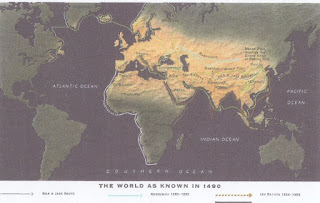 Then followed the scientific discoveries when expeditions by land and sea had exploration for knowledge as their aim. the greatest leader for such an was Captain Cook (Captain James Cook, FRS, RN (7 November 1728[NB 1] – 14 February 1779) was a British explorer, navigator, cartographer, and captain in the Royal Navy. Cook made detailed maps of Newfoundland prior to making three voyages to the Pacific Ocean, during which he achieved the first recorded European contact with the eastern coastline of Australia and the Hawaiian Islands, and the first recorded circumnavigationof New Zealand.),
Then followed the scientific discoveries when expeditions by land and sea had exploration for knowledge as their aim. the greatest leader for such an was Captain Cook (Captain James Cook, FRS, RN (7 November 1728[NB 1] – 14 February 1779) was a British explorer, navigator, cartographer, and captain in the Royal Navy. Cook made detailed maps of Newfoundland prior to making three voyages to the Pacific Ocean, during which he achieved the first recorded European contact with the eastern coastline of Australia and the Hawaiian Islands, and the first recorded circumnavigationof New Zealand.), who in only three great voyages explored Australia, New Zealand, Circumnavigated Antartica and sailed through the Bering Strait . Explorationm by land was slower and it was not until the nineteenth century that English and American expeditions crossed North America and south America was fully penetrated.
who in only three great voyages explored Australia, New Zealand, Circumnavigated Antartica and sailed through the Bering Strait . Explorationm by land was slower and it was not until the nineteenth century that English and American expeditions crossed North America and south America was fully penetrated. Africa was the last major continent to be crossed . Serious exploration was begun in 1795 by Mungo Park (Mungo Park (11 September 1771 – 1806) was a Scottish explorer of the African continent. He was the first Westerner known to have travelled to the central portion of the Niger River.)
Africa was the last major continent to be crossed . Serious exploration was begun in 1795 by Mungo Park (Mungo Park (11 September 1771 – 1806) was a Scottish explorer of the African continent. He was the first Westerner known to have travelled to the central portion of the Niger River.)
in West Africa , and thirty years later the Lauder Brothers (I profiled brothers Ronald and Leonard Lauder in 2002 as two of the world’s top collectors, patrons, philanthropists, and chairmen of major New York museums. They talk every day and buy art almost as often.)
found the mouth of the river Niger.
 In 1849, David Livingstone , (David Livingstone (19 March 1813 – 1 May 1873) was a Scottish Congregationalist pioneer medical missionary with the London Missionary Society and an explorer in Africa. His meeting with H. M. Stanley on 10 November 1871 gave rise to the popular quotation "Dr. Livingstone, I presume?" Livingstone was one of the most popular national heroes of the late 19th century in Victorian Britain, and he had a mythical status which operated on a number of interconnected levels: )
In 1849, David Livingstone , (David Livingstone (19 March 1813 – 1 May 1873) was a Scottish Congregationalist pioneer medical missionary with the London Missionary Society and an explorer in Africa. His meeting with H. M. Stanley on 10 November 1871 gave rise to the popular quotation "Dr. Livingstone, I presume?" Livingstone was one of the most popular national heroes of the late 19th century in Victorian Britain, and he had a mythical status which operated on a number of interconnected levels: )
The major interest was then centred round the north and south polar regions. In 1909 the American , Peary , was the first to reach the north pole and in 1958 the American submarine .
who usually travelled alone and was perhaps the greatest land explorer ever known , began his journeys in southern and central Africa ; his work was continued after his death by his friend , Stanley.
 In 1911 the Norwegian, Amundsen (Roald Engelbregt Gravning Amundsen(Norwegian: [ˈɾuːɑl ˈɑmʉnsən]; 16 July 1872 – c.18 June 1928) was a Norwegian explorer ofpolar regions. He led the Antarctic expedition of 1910–12 which was the first to reach the South Pole, on 14 December 1911. In 1926, he was the first expedition leader for the air expedition to the North Pole.) ,
In 1911 the Norwegian, Amundsen (Roald Engelbregt Gravning Amundsen(Norwegian: [ˈɾuːɑl ˈɑmʉnsən]; 16 July 1872 – c.18 June 1928) was a Norwegian explorer ofpolar regions. He led the Antarctic expedition of 1910–12 which was the first to reach the South Pole, on 14 December 1911. In 1926, he was the first expedition leader for the air expedition to the North Pole.) ,
was the first to reach the south pole , followed a month later by the later by the Englishman, Scott, and in 1955-1958, Sir Vivian Fuchs led a british Commonwealth expedition which crossed the Antartic continent from the Weddell Sea to the Ross Sea.
















